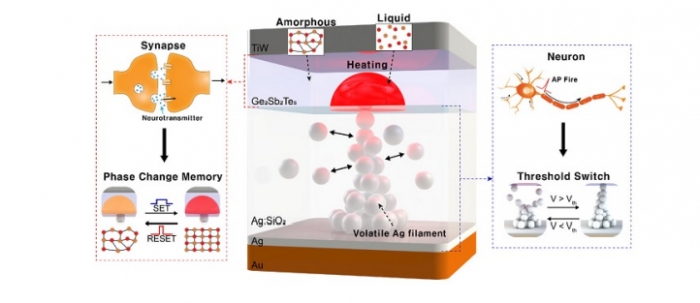Artificial intelligence
KAIST develops brain-like, large-scale memory system
The new artificial neuron and computing system boasts higher reliability and yield than the existing models
By Jun 08, 2022 (Gmt+09:00)
2
Min read
Most Read
Samsung shifts to emergency mode with 6-day work week for executives


CJ CheilJedang to sell feed, livestock unit for $1.4 bn


Samsung Electronics' key M&A man returns; big deals in the offing


Affinity to buy SK Rent-a-Car at $572 mn, more deals expected


Keppel REIT to sell Seoul-based prime office T Tower



The Korea Advanced Institute of Science & Technology (KAIST), a prestigious South Korean university, has developed a highly-reliable, large-scale memory system to handle vast amounts of data at fast speeds like a human brain.
The College of Electric Engineering from KAIST said on Tuesday that the memristor crossbar array it recently developed has resolved the reliability problems, one of the main obstacles to the development of memristor-based artificial neurons and neuromorphic computing.
Memristor is considered a next-generation technology for brain-inspired computing, or the original technology to build high-density neuromorphic artificial intelligence systems.
A human brain consists of a complex network of 100 billion neurons and 1,000 trillion synapses between neurons. Neurons communicate with one another through synapses.
Artificial neurons and neuromorphic computing have been studied as a means of emulating the working modes of neurons and synapses for use in AI and big data.
Differentiating itself from the existing neuromorphic computing systems, KAISTŌĆÖs large-scale memristor crossbar array boasts 100% yield and higher reliability.
Reliability issues had made it difficult to build large-scale memristor-based neuromorphic computing hardware.
Further, the array is more energy-efficient and processes a larger amount of data, alongside a simpler fabrication process, compared with the traditional computers based on the current artificial neural networks such as graphic processing units.
ŌĆ£We expect this new artificial neuron network to contribute to realizing a next-generation memristor-based neuromorphic computing system,ŌĆØ KAIST researcher See-On Park said in a statement.
Additionally, it will likely be used in diverse applications, including for robots with the ability to sense a touch and handling sequencing and time-series data, and serve as the foundation for future electronic engineering, he stated.
Memristors store information in the form of resistance by changing the internal distribution of oxygen anions or metal cations. They can change their resistance state in response to external electrical stimulation, as neurons in a human brain work.
To enhance its reliability, KAISTŌĆÖs memristor array switches its resistance state through oxygen migration, instead of conductive filaments through which the existing memristors operate.
This development was published in the June edition of Naturae Communications, titled ŌĆ£Experimental demonstration of highly reliable dynamic memristor for artificial neuron and neuromorphic computing.ŌĆØ
Write to Hae-Sung Lee at ihs@hankyung.com
Yeonhee Kim edited this article.
More to Read
-
 Aerospace & DefenseHanwha, KAIST to co-launch space research center
Aerospace & DefenseHanwha, KAIST to co-launch space research centerMay 17, 2021 (Gmt+09:00)
1 Min read
Comment 0
LOG IN


